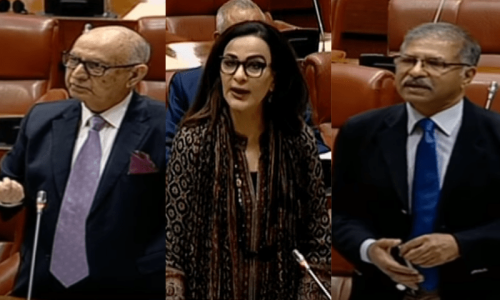The year that is to close on Dec 31 was one of sharp volatility for the Pakistan stock market.
Over the calendar year 2020, the benchmark index climbed to 43,417 points on Dec 24, from 40,735 points on Jan 1, recording nominal gains of 2,682 points or 6.58 per cent. The year started out on a positive tone, but Covid-19 came in February. Business, industries and markets were devastated and the index started to tumble, settling deep down the dungeon at 27,229 points on March 25.
As the country started to come to grips with the situation and the pandemic caused much less damage to the economy than was feared, the stock market started to recover. The index catapulted by a staggering 16,188 points in the nine-month period from March 25 to Dec 24, providing a mouth-watering return of 59pc. Without the massive pullback from the March lows, the year would have joined the two gloomy years of negative stock returns: minus 15pc in 2017 and minus 8pc in 2018. In 2019, the equity return was 10pc.
The Economic Survey for 2019-20 released on June 11 had also painted a bleak picture of the stock market. The survey blamed Covid-19, stating that between Feb 26 (when the first Covid-19 case surfaced in the country) and the end of March, Rs1.58 trillion was wiped off market capitalisation. The main equity index managed to bounce back post-March, the survey stated.
Four Initial Public Offerings (IPOs) were witnessed in 2020 which together raised Rs8.4 billion. These included IPOs of Organic Meat Company, Agha Steel Industries, TPL Trakker and Engro Polymer preference shares. A senior market participant commented that Pakistan needed “sustainable economic growth and political stability for big IPOs”. The IPOs during the year were nonetheless highest in five years. In 2019, the bourse had seen just one IPO of Rs5bn. Besides the primary market, companies also asked shareholders for cash in rights issues: 14 rights offerings were made that mobilised Rs27bn.
In 2020 (until Dec 24), foreign investors sold Pakistani stocks worth $525 million. Local investors mopped up liquidity with the highest buying by insurance companies amounting to $224m, followed by individuals who put their faith and money in equities in the sum of $212m. A veteran broker said that after an initial euphoria over Pakistan’s retention in the Emerging Market (EM) Index by New-York based MSCI Inc, which belied concerns of a downgrade to the Frontier Market (FM) Index, foreigners stepped back. Pakistan stood out as a small dot in terms of weight in the MSCI EM against 8pc in MSCI FM.
The later part of the year also provided comfort to investors as corporate profitability in the third quarter (July-September) stood at Rs210bn, signifying a jump of 39pc from a year ago. “It was the highest quarterly increase in corporate profits in any year. Quarter-on-quarter profitability also recorded stellar growth of 52pc,” said the head of equities at a local brokerage firm.
For the nine-month period, aggregate earnings of the companies that make up the KSE-100 index stood at Rs479bn, up 3.9pc from a year ago. A fortnight ago, Asad Umar tweeted: “Industrial growth accelerates as economic recovery gathers pace. Large-scale manufacturing grew by 5.46pc in July-Oct against same period last year.” He observed that growth was even higher at 6.66pc versus October last year. Market strategists said that strong recovery would continue, thanks to low interest rates.
Earlier former chairman of the stock exchange, Arif Habib, told this writer that five sectors held as much as 70pc weight in the KSE-100 index. They include oil and gas exploration and production, power, banks, fertilisers and textiles, which led the stock rally and were later followed by other sectors. Several equity strategists observed that the yield on the 10-year Pakistan Investment Bonds (PIBs) had receded. The yield on the long-term government paper sank below the benchmark interest rate for the first time in a decade, which led the government to cut the rate of return on National Savings Schemes (NSS). With no comparable investible asset, funds started to flow into stocks and the market was swamped with liquidity.
Zulqarnain Khan, executive director of Next Capital, provided a synopsis of the outgoing year. It started on a chirpy note with the end to JUI-F’s sit-in. The index thus shot up by 7pc to a high of 43,468 points in the month of January. Banking and oil sectors mainly led the surge. But the chirping proved short-lived as the advent of the first case of Covid-19 in February prompted a nationwide lockdown. The index tumbled 59pc by March. Brent Crude, which had touched $71.75 a barrel in January, dropped dead to $15.98 a barrel by April.
Mr Khan recalled that between March and June, the SBP slashed the interest rate by 625 basis points to 7pc to revive the economy. The government also announced massive incentive packages for the construction industry, which led to a V-shaped economic recovery post-lockdown.
“This was rejoiced by the market and the index surged 59pc from its low by September. Earnings growth in September resulted in sustained recovery and the index now sits at an intra-day high of 43,955 points. Major sectors that led to the index upsurge include cement, technology, steel, pharmaceutical and packaging.”
Published in Dawn, The Business and Finance Weekly, December 28th, 2020















































